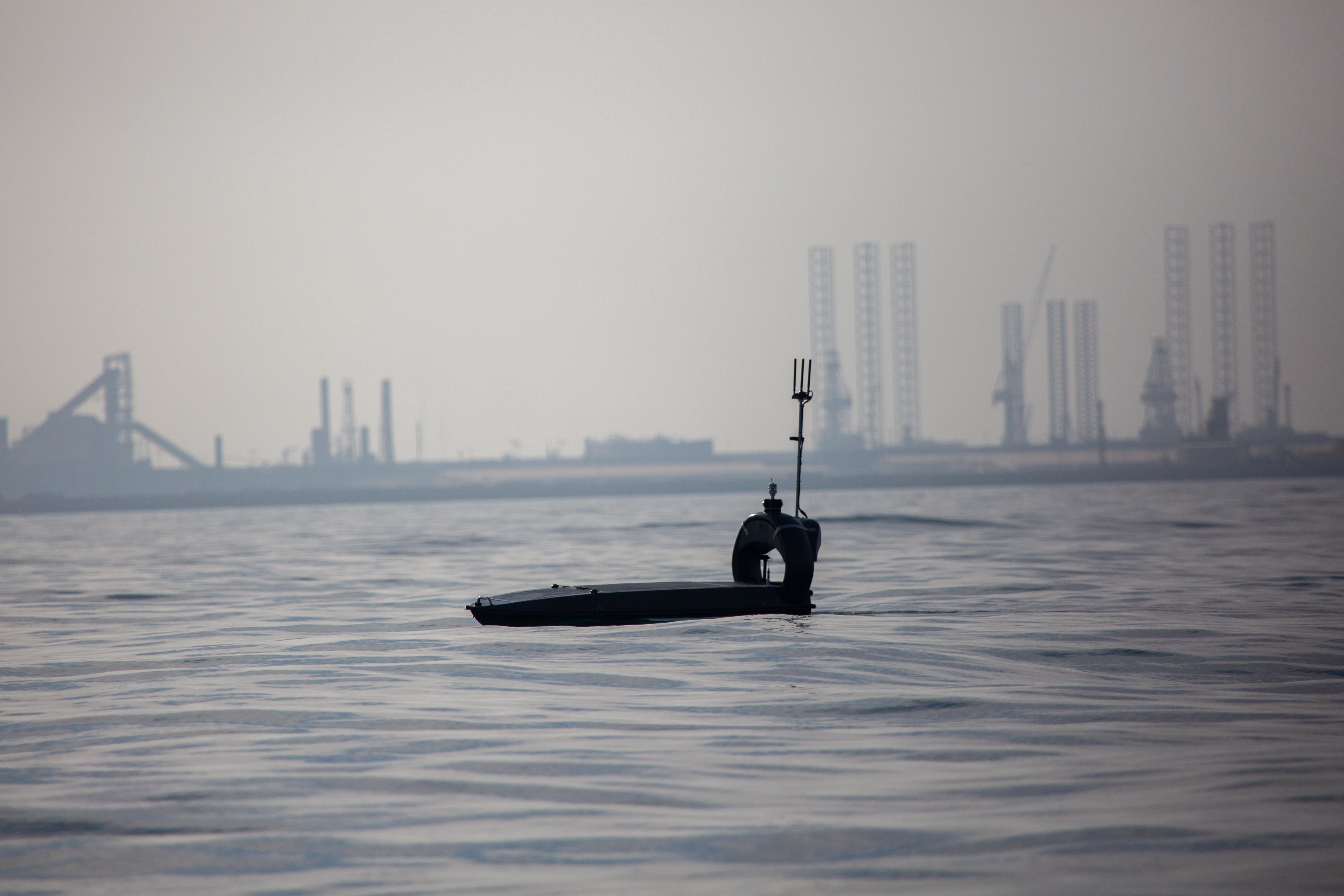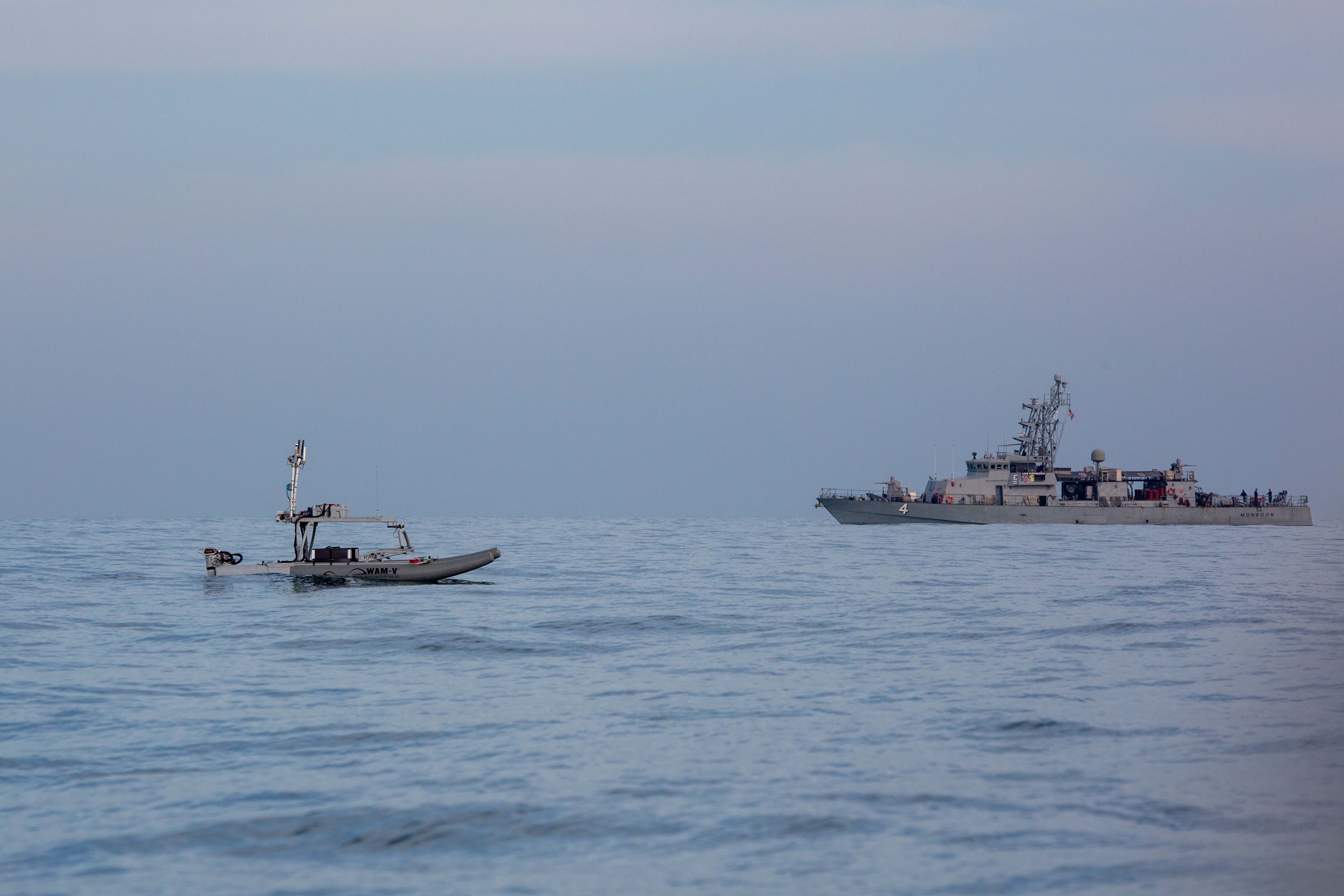WASHINGTON — A first-of-its-kind naval exercise in the Middle East paired unmanned systems with a so-called mesh network and data-crunching tools to demonstrate a promising use for the future unmanned fleet: cuing crewed ships and planes to problem areas.
Task Force 59, established to rapidly integrate unmanned systems with artificial intelligence for maritime applications, has been operating for more than a year now in U.S. 5th Fleet. The ongoing Digital Horizon exercise showcases such operations at an unprecedented scale, according to the exercise commander.
Manned-unmanned teaming, and specifically this cuing concept, is at the heart of what Task Force 59 has been working on, Capt. Michael Brasseur, the commodore, told Defense News in an interview.
“We see the unmanned assets as a way to get a bunch of eyes out on the water, collect the data, and then leverage machine learning and [artificial intelligence] to gather insights from that so we can be more precise in how we deploy our manned assets,” he said.
The exercise, which kicked off Nov. 23 and runs through Dec. 15, includes 17 industry partners bringing 15 different unmanned systems, 10 of which are being operated in 5th Fleet for the first time, the Navy said in a statement.
Brasseur said these unmanned surface and aerial systems are the best of what industry has to offer and performed well during the exercise. Some of the surface vessels are long-endurance craft meant to perform persistent surveillance missions, some are high-speed intercept craft, and some fall in between. On the aerial side, platforms include two vertical take-off and landing systems, Aerovel’s Flexrotor and Shield AI’s V-BAT, as well as Easy Aerial’s tethered UAV, according to the Navy statement.
The key, Brasseur said, was to put them in a realistic operational environment and push them to their limits to understand their true capability.
During the exercise, Brasseur’s team first established the mesh network and other communications systems. They then began daytime operations of the drones before moving on to round-the-clock operations.
“We ran a series of vignettes that looked like real-world situations that we would see in and around the waters surrounding the Arabian Peninsula, so we were able to test how the systems could respond and also detect these sorts of occurrences,” he said.

A top takeaway for the commodore is “the importance of the mesh network, which is the main mover for the data — not only to collect the data to power the machine learning and AI tools, but also to control the unmanned systems,” he said. “So we did some really groundbreaking work in terms of testing and deploying a resilient mesh network in an operational environment, during which we were able to work through some challenges and ultimately get the data flowing in a quite compelling way.”
Mesh networks, made up of multiple points called “nodes,” are wireless radio devices that communicate with one another, creating an overlapping “mesh” that needs no central hub and allows for quick and efficient data routing.
Brasseur added that previous exercises and operations over the last year have picked at different pieces of the puzzle, but Digital Horizon seeks to tackle the entire challenge of manned-unmanned operations in a single, seamless operation.
“We have done a lot of work with AI previously, and we’ve done computer vision, we’ve done anomalous behavior detection, we’ve done AI-enabled [command and control], but we’ve done all of those separately,” the commodore explained. “At Digital Horizon, for the first time ever, we did that together on a single stack, and that’s all integrated on a single pane of glass.”
“What that does is, it allows the end user to make decisions quicker and leverages artificial intelligence to make sense of all those data streams that are flowing in to a single pane of glass,” he added.
Over the last year of Task Force 59′s operations, Brasseur said, the cycle of development might allow for software changes to be made in weeks and hardware changes to be made in months.
At Digital Horizon, “we were seeing software changes within hours and hardware changes within days,” he said.
As a result, he said Task Force 59 is now “lightyears ahead of where we were” in February, when it hosted the largest unmanned exercise to date, International Maritime Exercise 2022.
“We don’t have any intention of slowing down. We are accelerating, we’re learning at a pace that’s just really, really impressive, and we are iterating at a pace that’s even more impressive. So we will apply the lessons we’ve learned here at [IMX 2023], but also during operations the fleet does every day,” Brasseur said.

These lessons won’t be confined to just 5th Fleet, the Navy has made clear.
Navy Secretary Carlos Del Toro told Defense News in a November interview that he wanted to export what Task Force 59 was doing — using cheap and plentiful unmanned systems to help cue the movements of more limited manned ships and planes — to Central and South America.
Earlier this month, he reiterated that the Navy “will soon expand that capability to other regions of the world — into Central and South America, and the Indo-Pacific.”
Following that Dec. 8 speech, Del Toro told Defense News that the operating environments in 5th Fleet versus 4th Fleet for Central and South America are different, but that unmanned systems would benefit them in the same way.
“The tactical environments are different,” he said. “The concerns and the threats are different. Much of what we do in 5th Fleet is about monitoring the activities of Iran. Down in Central and South America, it largely has to do with the counter-drug mission, especially in the Caribbean, and it also has to do with illegal fishing.”
“When I met with the president of Panama, for example, he made it clear that many countries in Central and South America are really challenged by these Chinese fishing fleets, and they don’t have the necessary resources in terms of ships and airplanes to counter the threat, and they need more resources to properly cue the resources they do have,” Del Toro said. “So by being able to use unmanned technologies, not only will we be able to help them, but they can be able to help themselves. So this has been an ongoing conversation I’ve had with numerous leaders, heads of navies, and they see the definite advantage.”
Without giving a specific timeline for when a new unmanned task force might be established in 4th Fleet, Del Toro said the Navy was continuing talks with its regional partners about what the organization might look like. Mexico, he added, was even beginning to develop its own unmanned systems for use in this maritime domain awareness-focused task force.
Brasseur said representatives from several numbered fleets attended Digital Horizon and saw the unmanned fleet in action. The beauty of the live event, both for Middle Eastern countries considering joining Task Force 59 and other fleet leaders considering establishing their own unmanned task force, is that “it shows them the art of the possible, and then it unlocks opportunities of how you could use these systems in new and innovative ways.”
Megan Eckstein is the naval warfare reporter at Defense News. She has covered military news since 2009, with a focus on U.S. Navy and Marine Corps operations, acquisition programs and budgets. She has reported from four geographic fleets and is happiest when she’s filing stories from a ship. Megan is a University of Maryland alumna.








